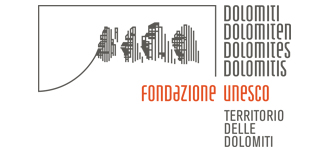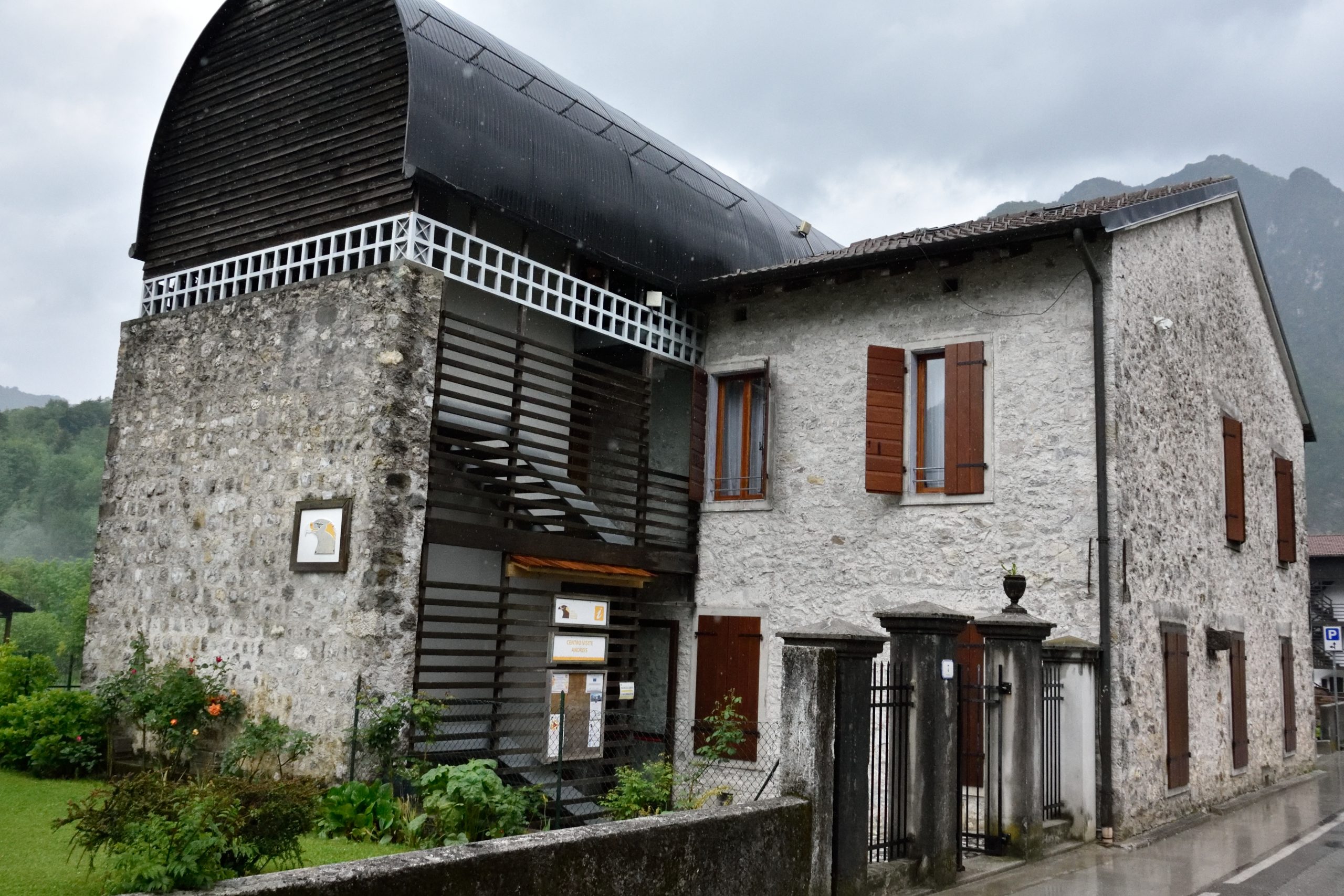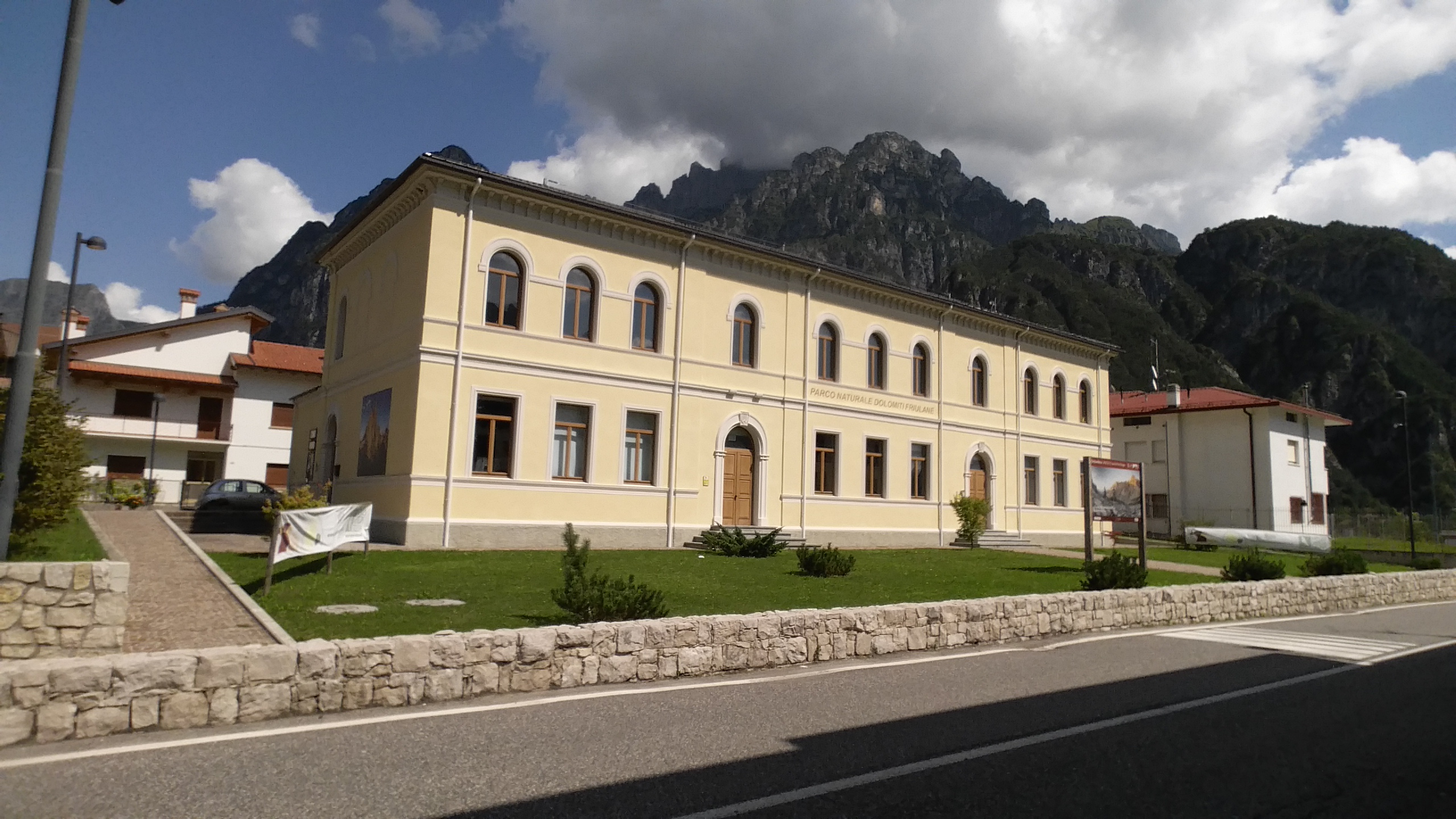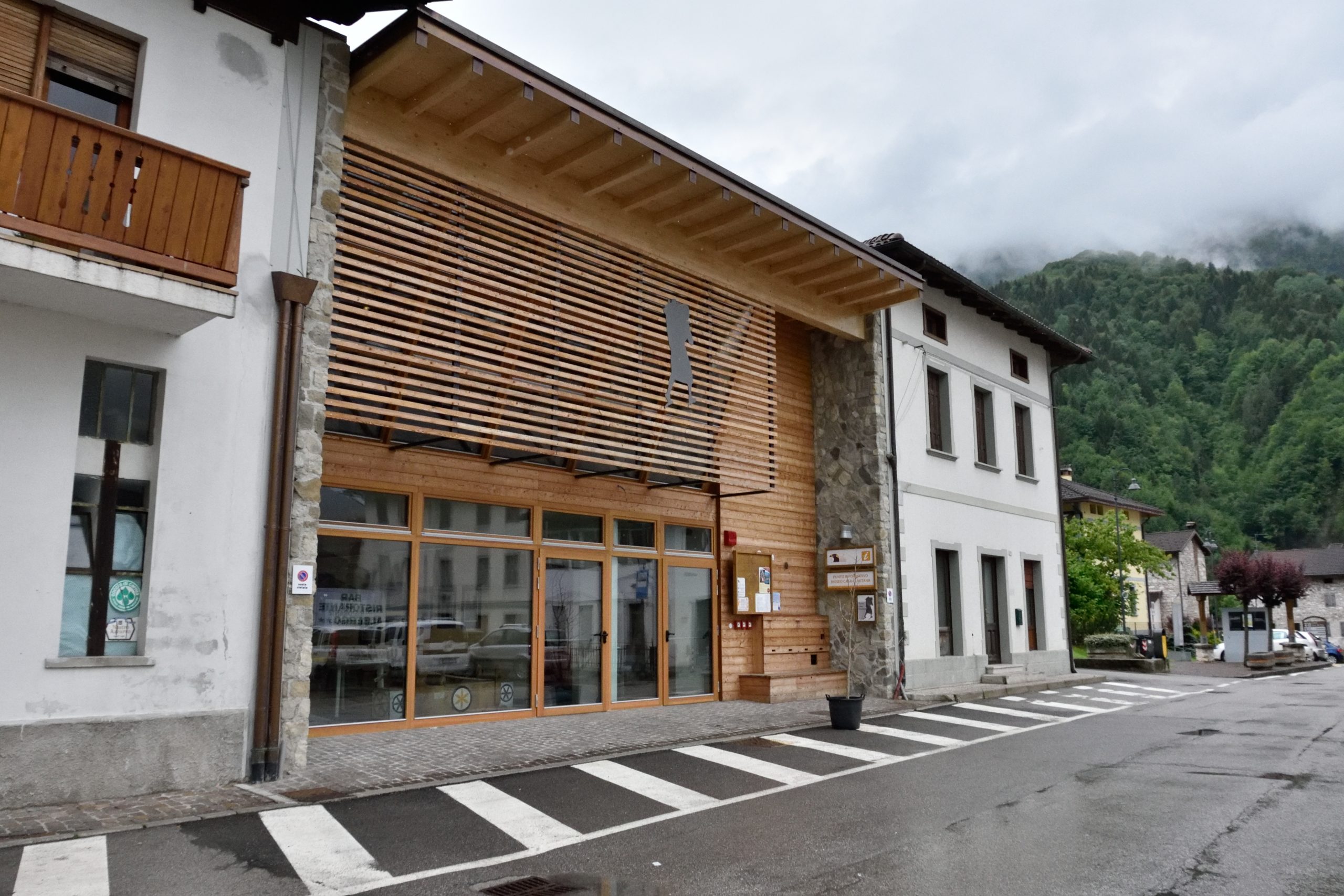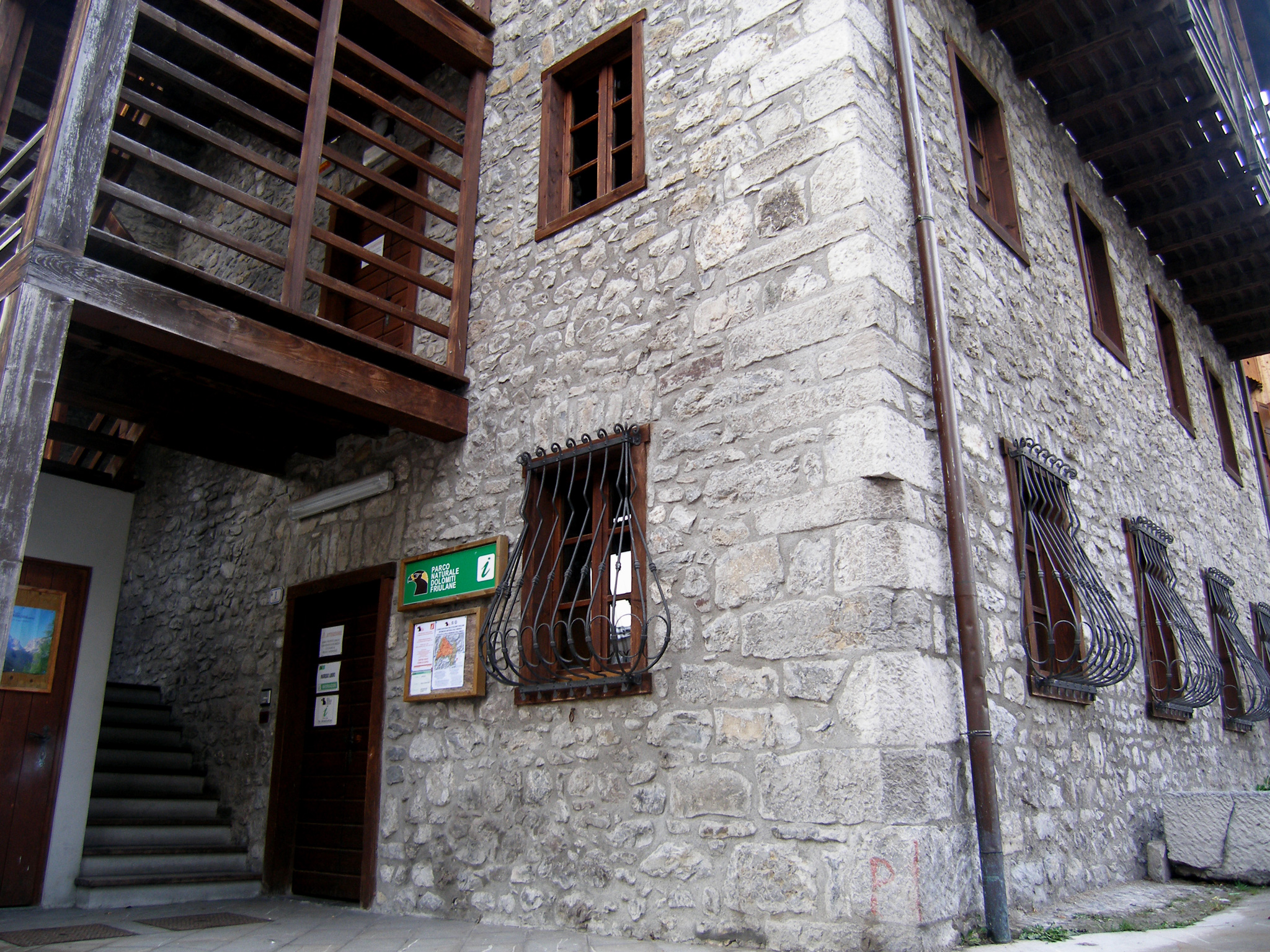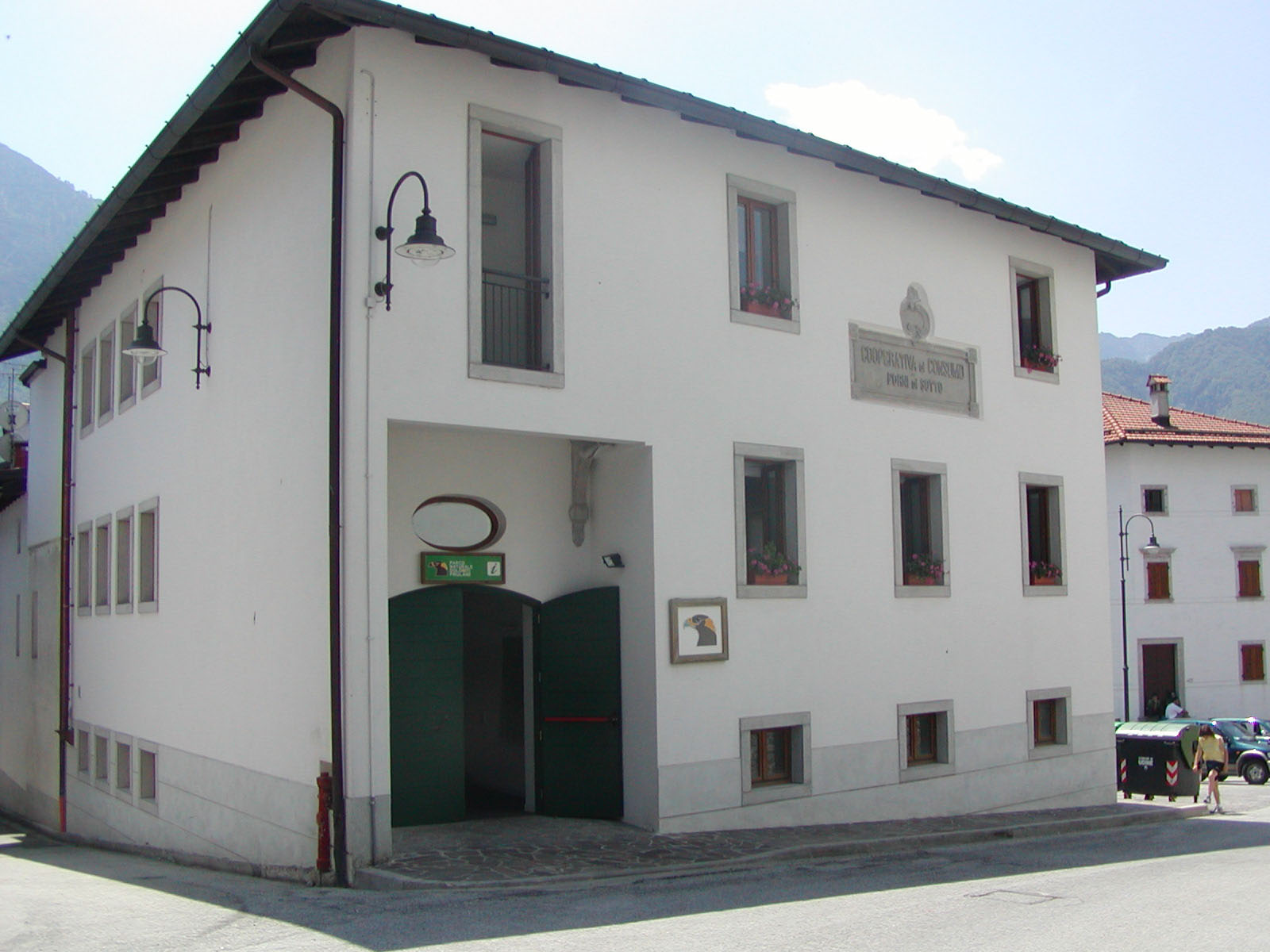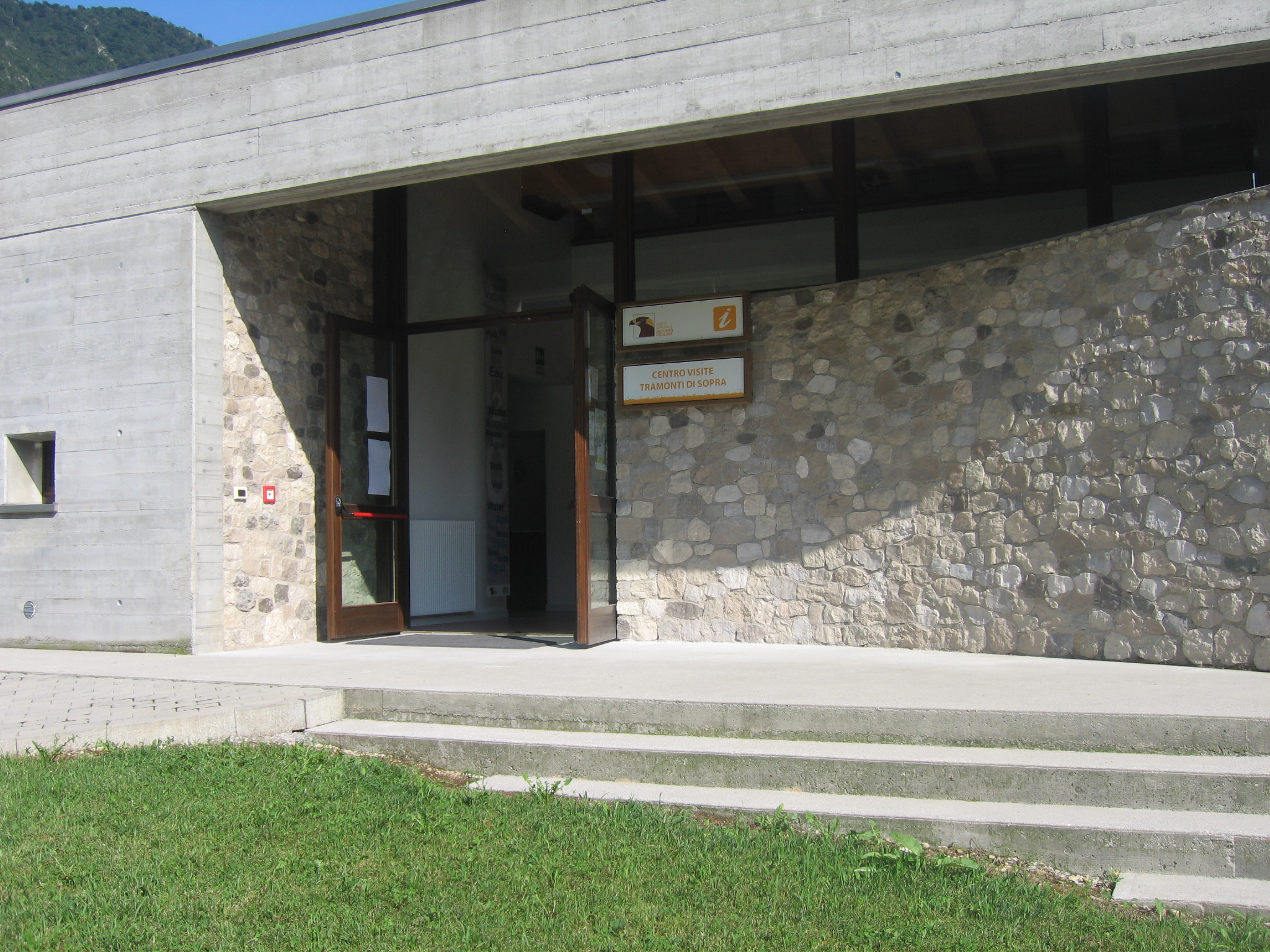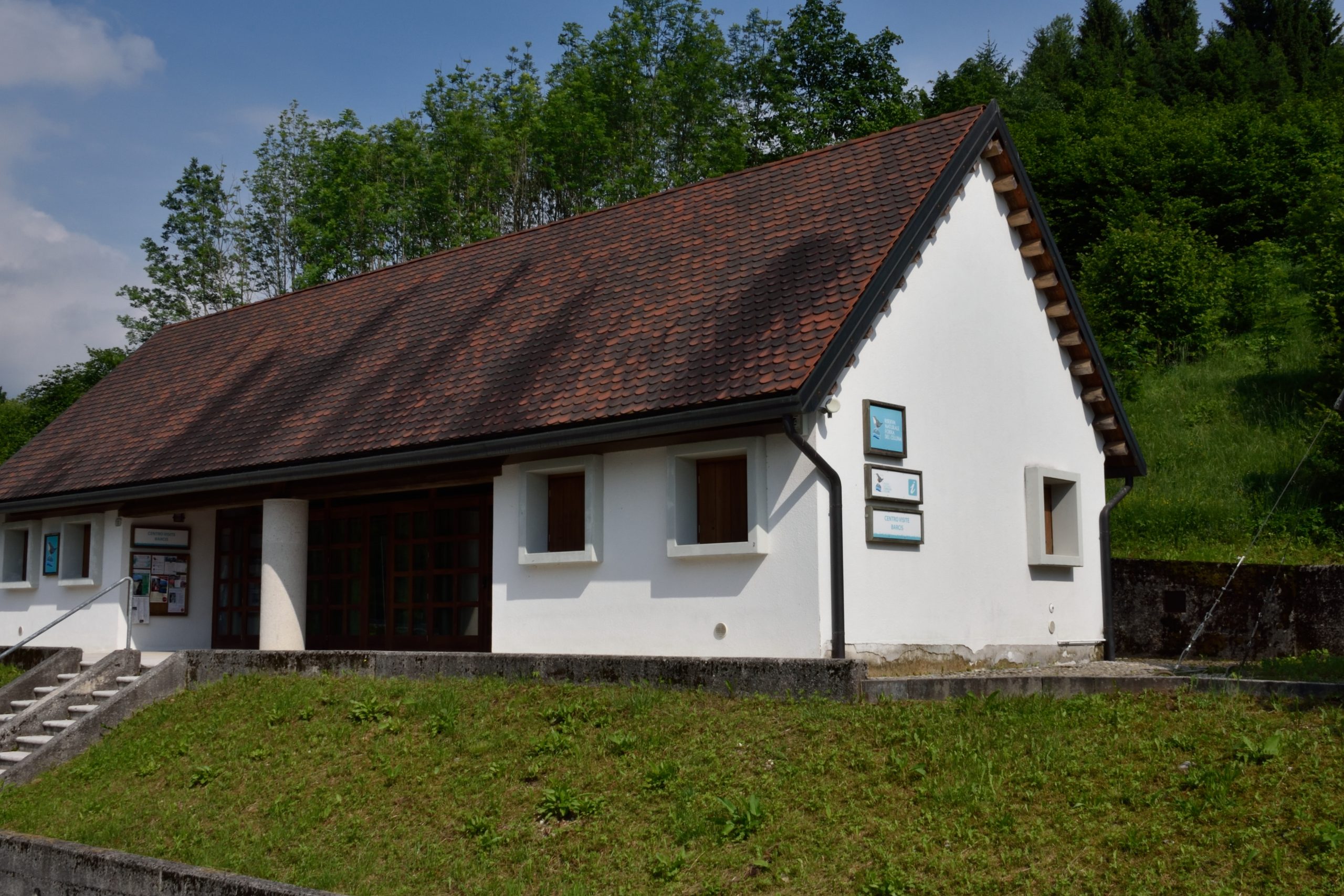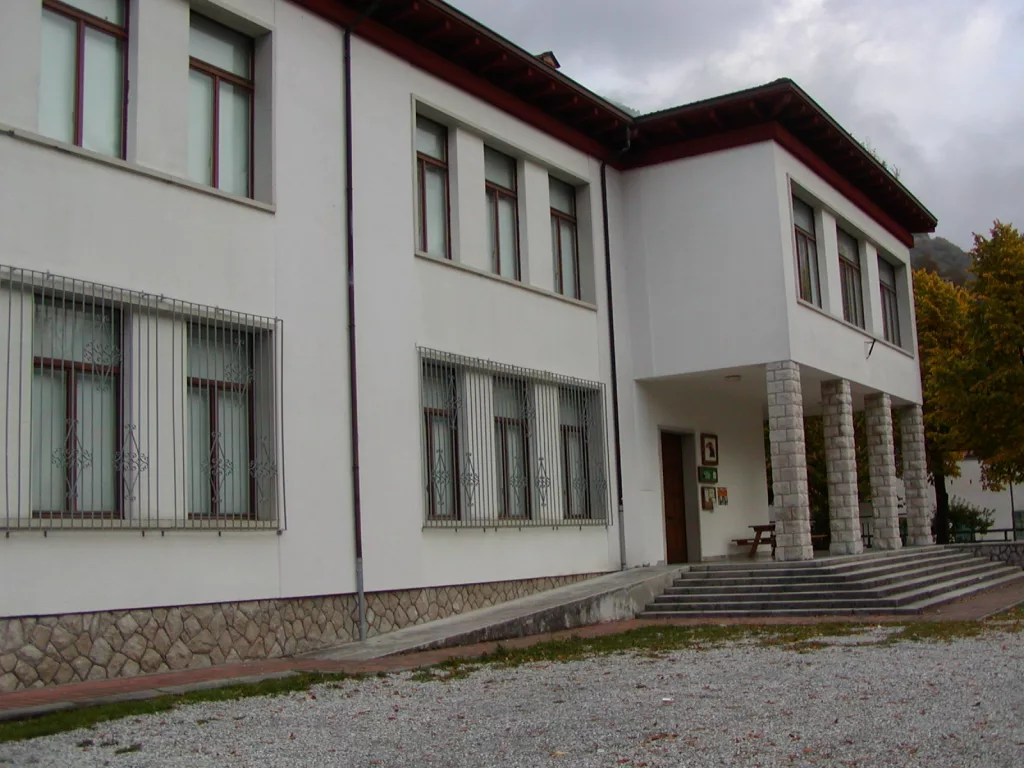ORARIO DI APERTURA DAL 1 GENNAIO AL 31 MAGGIO 2025
Aperto da Pasqua la Domenica 14.00-17.00
APERTO ANCHE DURANTE QUESTE FESTIVITÀ:
Da Mercoledì 1 gennaio a Lunedì 6 gennaio 2025 15.00-19.00
Sabato 11 gennaio e Domenica 12 gennaio 2025 15.00-19.00
Domenica 20 aprile e Lunedì 21 aprile 2025 14.00-17.00
Da Venerdì 25 aprile a Domenica 27 aprile 2025 14.00-17.00
Da Giovedì 1 maggio a Domenica 4 maggio 2025 14.00-17.00
EXHIBITIONS “THE POFFABRO DAIRY” AND “IN MONT – THE PASTURES OF THE PARK”
The Frisanco Visitors Center is housed in the building of the former dairy in Poffabro. The building, opened in April 1933, it is now divided into four sections: the real cheese factory on the ground floor; the pastures and natural features of the Park and Val Colvera on the second floor. On the ground floor, after a brief digression on the history of the regional dairies, it is given particular attention to that of Frisanco, from the first meetings to the establishment of the Social Dairy Company of Poffabro-Casasola in October 1932, from the inauguration of the building in 1933, to its organization and functioning until the second half of the ’60s. The dairy processing room is maintained with the original machinery and cheese processing equipment (’30s); a particular attention is given to the operating system of transmission belts moved by a small electric motor, the fixed system boilers for the heating of milk and the cheese press bench with movable weights (Friulian system). The upper floor houses an introductory section on the environment of the Park, presenting the geomorphological and vegetation aspects and the animal and plant species in the protected area. A special area is dedicated to Val Colvera that hosts this Visitors Center and to its architectural-landscape and geological aspects. The permanent exhibition “In mont – the pastures of the Park” shows the inside of the dairy with the fireplace reproduction and all the utensils for the processing and transformation of milk into cheese, butter and ricotta. A multimedia station instead gathers the certificates so far collected on existing dairies (also as ruins) in the Park: a rich reality that is progressively disappearing, but that has always represented an important supplement of the family income.
- INDIRIZZO: Piazza XX settembre, 1 33080 Poffabro (PN)
- TELEFONO: +39 042787333
- EMAIL: info@parcodolomitifriulane.it
Land of great craft traditions gathered all in Frisanco and in the hamlets of Poffabro, Casasola, Colvere, Pian delle Merie and Valdestali, where the rural architecture is characterized by houses with three or four floors with wooden balconies supported by tall stone pillars.
Dominated by the summit of Mount Raut, Val Colvera is crossed by the same name river that along its course has shaped the rocks into typical cavities like Landri scur and Landri viert and has created an impressive gorge named Bus del Colvera . The municipality is divided into many small villages placed in proximity of rivers or on the sunny slopes of the hills that characterize the valley. The valley carved by the Colvera river opens towards the plain of Maniago with a characteristic and picturesque gorge of calcareous walls, vertical in some sections.
BACKGROUND HISTORY
Date back to the Middle Ages the first information about Poffabro and Frisanco: in a judgment of 1339 concerning a dispute for borders, they were are already mentioned as settlements built on the estates of the spouses of Maniago and Polcenigo. Fabio from Maniago speaks about the origin of Poffabro, at the foot of Mount Raut on the left side of the Colvera river from families who had leased farms from the spouses of Maniago in the area.
Frisanco would have had a similar origin, from the rental, sale and exchanges carried out in the area by the Counts of Polcenigo and from the Fanna and Cavasso communities until the sixteenth century. The village of Casasola instead was born from a few scattered houses on a former farm. The name is mentioned for the first time in 1436, while a document of 1624 speaks of four “alone houses”, as many of the main branches of the family Di Rosa settled there. In 1644 Poffabro and Casasola coalesced into one village under the Counts of Maniago, while Frisanco remained under the Counts of Polcenigo.
The entire period between the seventeenth and eighteenth century is marked by quarrels between Maniago and Poffabro about pastures and haying rights, between Poffabro and Casasola for the Mount Radolin and so on, among events that see pastures overrunning, illegal cutting of lumber, theft of goats and fodder, accusations and counter accusations. The merging into a single municipality took place only in the Napoleonic era (decree of September 28, 1810): Frisanco (788 inhabitants) became the capital, including Poffabro and Casasola (together 617 inhabitants).
TYPICAL ARCHITECTURE AND LANDSCAPE
The typical architecture is the most scenic and environmental value of the valley, thanks to careful renovation carried out following the damage caused by the earthquake of 1976. The exposed sandstone, arches and arcades, the galleries, the paved paths and wonderful ways of aggregation of the buildings are fascinating testimonies of the past customs and traditions, now almost disappeared. The mainly rural architecture, defined “spontaneous,” presents in most cases an aggregation of buildings, derived from common security reasons, savings in the construction and protection of the surrounding farmlands. Next to some old, valuable, lodge buildings, clearly prevails wood structures with galleries and vertical protections, both open terraced open or with court. The complexity, which derived from a morphological conditioning of the places and the limits of the property in the evolution inside the built-up areas, has led a remarkable architectural enrichment, due to the unity of language and materials.
The repetitiveness of the architectural elements (materials, shape and arrangement of the rooms, sloping of roofs and more) and the continuity of the facade make the environment look as a whole. Despite this, the different heights of the buildings, the different extensions of the pitched roofs, the different lengths of the facades, their arrangement almost never in lined up, the different shades of color, the alternation of buildings and protection walls, prevent the unity from becoming uniformity and convey expressive richness to the environment.
In this context a particular importance is assumed by the seemingly minor decorative motifs: the carving of a wooden wall, the sculpture of a fruit on a fence, the reference to the cultural traditions of the area. And just these details give meaning and flavor to the spontaneous architecture. (Taken from E. Pascolo, guidebook about construction projects in rural areas, 1978). In the territory that extends between the Colvera and Muie valleys, in a zone out from the major population centers are distributed some smaller towns and loucs, result of an deep colonization of the area and a very intense use of the land (meadows, pastures and woods ), which remains constant up to the first post-war period.
In the loucs people lived and worked in spring and summer from May to September; consisting of a private house, barn-hayloft and surrounding plot, they represent a common element of the entire landscape, now witnessed by the myriad of buildings invaded by the woods.
THE CONSTITUTION
After a series of passionate meetings organized by the parish priest Don Tranquillo Miniutti at the request of some of the main breadwinners, at the headquarters of the Workers’ Association of Poffabro, on the 24th of October 1932 was formed the “Social Dairy of Poffabro” to which belong the people of Poffabro, Casasola, Val di Frina, Colvere, Pian delle Merie and Borgo Rioni. Article 2 of the bylaws defines among the objectives of the new company: the rational processing of the milk produced in the members’ stables, with the exception for goat milk, exceeding the home consumption, and cattle breeding; the restitution to each member of the products derived from the processing of their milk and possibly the sale on behalf of the members of that extra part not necessary to their needs. The dairy includes supporting members, who provided labor and support for the manufacturing of the building but do not produce milk; stakeholder members, those who have purchased the membership fee (at the initial value of 100 lire) and bring the milk; simple shareholders, those who, due to distrust of the institution or for economic difficulties, are not members of the dairy, but they give it and also enjoy the benefits. Despite a certain mistrust coming from some local people, the Poffabro-Casasola Dairy was inaugurated on Sunday, April 9, 1933, with 70 members enrolled and 63 initial stakeholders which became 114 at the end of 1933. In the construction of the building were engaged in first person all members either for the simple labor, or for the supply of construction materials and the transport of goods, or for various supplies and commissions when the works began. For the realization and start-up of the dairy was asked for a loan of 40,000 lire to the Savings Bank of Udine, fully paid in 1945; while the machines were purchased from the Agricultural Federation of Udine.
TRANSPORTATION FROM VILLAGES
Done at the beginning by the cheese maker himself with a pickup truck-van purchased directly by the dairy, the transportation was soon entrusted, as a paid service, to individuals who committed themselves, using their own means, to pick up the milk and deliver it to the dairyman twice per day, in the morning and in the evening, following a specific agreement with the dairy.
THE CHEESE MAKER
The cheese maker is responsible for the direction of all dairy operations: he deals with the processing of the products, he takes care of the good seasoning and conservation, he maintains the premises, machines and equipment in perfect conditions and with the most scrupulous cleanliness, he weighs the milk at the conferment time and he distributes the products to all members. Mario Zuculìn said that the cheese maker started work at 6.00 in the morning, lit the fire, heated up the water, brought to the storehouse the cheese wheels of the day before and washed the cloths. At 7 AM he began the delivery of milk on behalf of the members … in winter the reception was held from 5.30 to 6.30 PM, in summer from 6.30 to 7.30. In his activity he was always assisted by two women.
THE WORKING DAY
Depending on the amount taken, the members processed the milk in turn. In a working day the shareholder must provide the labor and the necessary amount of timber, also he had to pay a processing fee that was defined by the Institution itself. During the Saint Biagio day (February 3) the work was intended for the parish and one Monday per month the cheese sale was offered to the church for the celebration of a Mass for the souls’ intercession.
FASCISM AND WAR (’30S -’45S)
Even the dairy was subject to the restrictive rules of the Fascist period that imposed prices of milk, cheese and butter. The Cheese Control Office oversaw the regular products distribution to shareholders with its storage in the warehouse of Maniago. From September 1943 to May 1946, both for the low intake of raw material (only 2 liters of milk per day) and not to deliver the products to the warehouse dairy was officially closed.
50S AND 60S
Remarkable is the increase in production since 1950 when the average of daily milk processed stood at 10 hectoliters, with peaks of 13 tons for a production of 13-14 cheese wheels of 6-8 Kg. The dairy performs a significant production and the number of members reaches 128 in 1957. In 1963, only 72 members are enrolled and the amount of milk decreases more and more due to the continuous increase of the processing fee. The cheese maker Mario Zuculin said that in the years 1963 – 1964, in winter, because of the lack of milk and save money on costs, processing was done on alternate days, and the last cheese-maker used to work in the dairy of Frisanco too. When in the second half of the 60s, the Poffabro Dairy was closed, those who still had cows brought the milk to the nearby Maniago and Navarons’ dairies.
PRODUCTION
Data on production were taken from the milk registers and from the processing books although in both cases the documents are incomplete. They relate to a period between 1933 and 1963. In the dairy were processed in total 68,740 liters of milk for a production of 6,030 tons of cheese and 885 kg of butter.
È la parola comune a tutti i paesi del Parco, per indicare l’attività malghiva che si svolgeva nel periodo estivo, in pascoli di media ed alta quota ( 1000 – 2000 metri). Ogni famiglia possedeva del bestiame, da uno o qualche decina di capi. Fin da tempi lontani si è praticato l’alpeggio, per poter sfruttare al massimo il territorio: andare “in mont” significava usufruire di una parte di territorio che altrimenti sarebbe stato inutilizzato e allo stesso tempo permetteva di provvedere al foraggio per la brutta stagione.
Oggi sono pochissime le malghe monticate, dopo la guerra lentamente l’attività è andata morendo, in seguito al rapido e continuo processo di industrializzazione che ha portato all’abbandono dell’allevamento del bestiame.
Il Parco pone attenzione al recupero delle attività del passato ed in particolare a quella malghiva, fonte di guadagno per la gente di montagna ma anche esempio di come l’uomo viveva in armonia con la natura. Le casere, ristrutturate rispettando l’architettura spontanea ma con servizi moderni, sono una speranza che l’antico mestiere del malgaro non scompaia dalle nostre valli.
ALPINE HUTS- PASTURES SITUATION
1903-1911 First census organized by Ionizzo and Marchettano on behalf of the Agriculture Associate Chair of the Friulian Agrarian Association: 267 alpine huts registered of which 169 in Carnia, 45 in Canal del Ferro, 53 in the districts of Maniago and Spilimbergo.
1915
After the First World War most of the 70 damaged or destroyed pastures is not restored.
1938
The census by Gortani, on the depopulation of the Friuli mountains, indicates 261 alpine huts: 164 in Carnia, 44 in Canal del Ferro, 13 and 40 in Val Canale in the Carnic Alps. The proximity of the number to the situation at beginning of the century hides “a very serious crisis, which is affecting ominously the area’s economy.”
1940
Only in western Friuli, on the eve of the Second World War, 131 huts are active, both municipal and private.
1985
68 are the active pastures in Carnia, 17 in Canal del Ferro and 6 in the Val Canale. In western Friuli they are 28 pastures.
1998
104 the pastures in the entire region.
THE MANAGEMENT OF THE PASTURES
From a legal-administrative standpoint the pastures of the Park are property of the municipality. The alpine hut is rented, through a tender procedure using the method of “the virgin candle”, to the highest bidder, usually for a period of nine years. In the Fornese area this is managed by cooperative association of farmers. The auction notice shows the alpine huts to be exploited for the pasture activity, the place, the date of the tender procedure and the basic price to offer. The tender dossier regulates the relationship between the herdsman, the Municipality and the owner of the livestock, indicating the rights and obligations of the herdsman in accordance with applicable forestry regulations. The tenant – the herdsman must operate for the maintenance of the pasture land through the weeds’ uprooting, the stones removal from the grassland and, at the end of the season, the manuring. He is also responsible for the maintenance of the building of the hut. Before the pasture activity starts he is concerned with the restoration of access paths, arranging the most inaccessible and dangerous areas. The number of cattle varies according to the size of the pasture. Usually it goes from 30 to 50 animals. In addition to the dairy cattle there are the Sterpa, goats, sheep and pigs. The number was reached by calculating the value of the beasts: two heifers or four calves or ten goats were equivalent to a cow. In the Fornese area was typical the sheep farming, the goat is found at the beginning of the twentieth century and then, perhaps even after the law that regulated the goat pasture, was reduced to few head of cattle . Through Giaf they reached Val Menon, Val de Brica and through Val di Sole they returned to their valley. The dates for the weighing of the milk in the presence of the livestock owners are fixed in such a way as to determine the products distribution based on the amount of milk: the day of St Peter (June 29) and the 25th or 26th of July. These weightings allowed to make an average of the total production, one occurred when the cow had a big production of milk and the other when the milk was running out because the cows were matured for the autumn calving. A quantity of products was for the priest and the vestry to be delivered within July 24, respecting each year the turn of the dairies. The period of pastures was fixed according to an ancient custom: they went up “in mont” to the pastures on June 7 and went down on September 7. While the return date was observed in every vilage, the departure was also linked to environmental conditions. In Cimolais, in the Feron area, people used to go up to the pastures on June 13, in the Fornese area on June 29, since the alpine huts were located at an altitude that varied between 1600 and 1700 meters and the custom was to move the cattle to stables that were located halfway between the village and the alpine hut. The alpine huts worked in turns, one was lower and the other higher. In the first period was exploited the lower hut (1000 – 1400 – 1500 m), and then they moved even with the equipment to the highest hut (1700 – 1800 m) and then returned to the lower one in the last period. This made it possible to easily use a wider territory and above all to follow the maturation of the fodder.
TYPE AND TECHNICAL ASPECTS
The term “alpine hut” indicates a mountain pasture land exclusively used for summer grazing, which has its own buildings for the company activities.It was normally chosen the safest place, sunny and rich in grass, near water courses, of vital importance especially for the animals. Through a system made of hollowed larch trunks water was brought in front of the hut and collected in a “laip” (hollowed trunk). There were also the blades, ie natural ground depressions (or man-made), beaten and waterproofed with clay for the rainwater supply. In Borgà, alpine hut in Erto without water, using a sledge people used to transport the eternal snow from the ravines near the “Books of San Daniele” and, put it in tanks adjacent to the hut, waiting then for its melting
ACCESSES
The alpine hut was served by a network of trails that allowed its activities: main paths, safe for animals, sometimes with protection walls (as in Col d’Aniei); secondary paths, faster and steeper for the exclusive use of the shepherd; connection paths between a pasture and the other and between zones of the same pasture area.
MATERIALS
The walls were made of local stone, bound with lime produced in the kilns near the hut. In Erto the huts were made of dry stone, with hand-hewn stone, while the shards were used as binder, filling the interstices. Small openings formed the windows. The roof was made of shingles, in larch planks processed on the spot (most recently of sheet). Only in Andreis, the roofing was different: they used the fescue, a plant of the grass family that grew wild on the pastures that appropriately beaten could guarantee a roof for a hundred years. The first alpine huts were made up of several separate rooms: in one people lived and processed the milk (dairy) and the in the other they stored products (small dairy). In Cimolais there was a third small box where people centrifugate cream. These buildings were huge houses made of wood logs, stuck together with wooden nails. Nearby there was the canopy, shelter for dairy cattle, while the heifers were left free or locked in an enclosure. For the sheep was also used a mobile fence that was moved daily in order to rationally distribute the fertilizer. The structures that we find today, date back to the twenties of the ‘900 and have the same characteristics. The alpine hut is composed of a single building, divided into several rooms. In the most spacious room people lived, processed the milk, spent their free time, cooked the poor meal with the inevitable polenta. Two stone steps upper there was the casel, the freshest and well-ventilated place where the products were preserved, and there were also the working equipment. A wooden staircase provides access to the upper floor, located above the casel. Four wooden planks made up the floor, while the bed was made with heather and dry leaves, placed over the branches of mountain pine. In the Fornese area instead there were large stables that wind around a large square space.
THE ALPINE HUT INDOORS
The indoor part of the alpine hut was very simple. The floor was made up of the earth itself, not even leveled, except by man’s steps, full of whey and smoke. The simple furniture consisted of some wooden stools. In one corner predominated “mussa” (common term for anything that brings something). It is a swivel axis, where the large pot that was hung there could be taken off and put back on the fire, according to the need, during the working process of cheese and ricotta. For the lighting was used a simple candle or an oil one and, going back in time, with the “alum”, that is to say a pine branch. Rarely artificial light was necessary because the fire warmed and lit up the place but mainly because the days were decided by sunlight. In the morning they got up at dawn and went to bed early, after a hard day’s work.
THOSE WORKING IN THE ALPINE HUT:
- The herdsman
He supervises the activity of the company, manages pastures and herds and hires staff. The departure day he left first, followed by the other owners, each with their own animals, or even those of a friend. Upon arrival he drew up the list, distinguishing cattle per family and checking the brand of each collar. The day started up early with milking (long and arduous task). The work was facilitated by the animals tied up under the canopy. Sitting on a stool with one foot, suitable for finding the right balance on rough ground, the milker was holding the breasts in a fist, pincer or pinch way according to his habit, or depending on the size of the cow’s breasts. He was in charge of the processing of milk, to get cheese, ricotta and butter.
- The shepherd
Usually they were kids, quite willingly sent to the pastures from the family that in this way had one less mouth to feed in the three summer months. A pair of boots are witnesses of their pace in the pastures to guard the animals but also of their earnings: it was the compensation they received after three months of work. They left in the morning, after helping the herdsman cleaning and massaging the breasts and, throughout the day, guarding the cattle in the pastures chosen day by day by the expert herdsman. This young shepherd erased loneliness carving wooden whistles and breaking the stones and then reassemble them: the “puzzle” of stones. A particular shepherd was the “pluovit” (= community work) in Forni di Sopra. His task was the maintenance of pastures through the stones removal, cleaning the paths and pools of manure. Usually there were two people that did the work for four huts.
- The carrier
Once ready, the products had to be carried downstream. This task was entrusted to the bearers. Only women in the male world of the pasture, they were paid to transport the household goods and products from the village to the alpine hut and from hut to hut, working in turns. Uphill they could carry 40 kg and downhill even 50-60 Kg. In fact these women were paid according to the transported pounds. Sometimes they worked in exchange for milk or a mount of oxen. Their transportation mean was the basket. The butter was usually protected from the sun with the burdock in the Fornese area or with the mountain pine in Valcellina.
- The collar
Common element to all villages of the Park, before leaving, every owner of cattle hung it on the beast’s neck. Hanging on it the bell rang following the animal’s gait and made the village’s people come. In the pastures that sound was important because allowed the shepherd to look for the missing animals. Cowbells were smaller and simpler, less loud. Instead the travel bells were rather large, important and there can be also three on a one collar; they were hung on the cows when they went to the pastures and when they came back to the village. Especially the return was considered a great event. The most beautiful cow had the honor of carrying the showy cowbell, her horns were adorned with flowers. The day of Our Lady, September the 8th was celebrated the shepherd’s feast: a Mass, a lunch and the due reward.
- Features and techniques
There were very simple collars, only interlocking, for goats. Others like those of Andreis decorated with carved floral or geometric patterns. The collars are the expression of human creativity of the past. There were skilled woodworkers who sold them but almost every herdsman knew how to carv them and he did this work during winter, at home, but also in the alpine hut, in his spare time. You could use various types of wood (larch, beech, mountain pine) but the most suitable and traditionally used, was the laburnum, a soft and at the same time resistant wood. The cut could be done in any season, provided with the waning moon, and selecting a part already naturally slightly curved, with 8-10 cm of diameter and height of 1.20 m. The most important thing then was to cut along the stem starting from the stump because the wood breaks more easily. The wood then was squared up and roughly shaped using an ax , leaving the two ends and the thicker center. In one part was carved the tap and on the other a hole. To remove the interior wood was practiced a small hole. With an iron tool it was finished off by smoothing the rough parts. To bend it was dipped in boiling whey, remained after the processing of milk and slowly bent, pressing it against the knee. With skill and imagination it was then decorated with floral or geometric patterns, engraving one’s initials with fire, as a sign of recognition. Finally were practiced the last hole to hang the bell and inserted the small key that ensured a perfect closure.
Located on the southern slope of Mount Raut, owned by the Counts Martinengo of Maniago, it was built between 1929 and 1930, with a pasture area of about 200 hectares.
The ascent to the alpine pastures with heifers or calving or animals, mules, sheep and goats, is made up of two structures: the low hut, now restored, located at an altitude of 950 meters and the high hut, in ruins, located at an altitude of 1120 meters. An aqueduct draws on the rivulet Martelin and leads to the storage tank located between the two huts.
The ascent to the pastures, that at full capacity, reached a total of 120 cattle and 200 sheep, took place, at the beginning of the season, in the stavoli Pecòl area, at an altitude of 750 meters. In late June, the cattle moved to the lower pastures and half of them stayed there, while the other half was transferred, from late July to September, to the higher alpine pastures.
In this alpine hut we do not find the dairy itself, for the processing of milk, since the grass of the pastures (mainly oat grass), hard and exposed all day to the sun, is not suitable for feeding dairy cattle, but only the meat ones.

